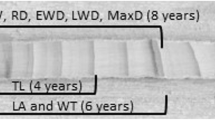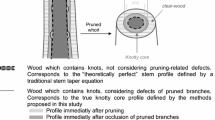Abstract
Pine plantations are an important wood source in Brazil, with Pinus taeda being most frequently planted. Most pinewood is directed to the paper and pulp industry, but there is an increasing demand for wood for solid end-uses, requiring large stems from longer rotations which can be obtained using P. taeda as the canopy in two-aged stands. We evaluated radial growth and wood density at different stem heights of P. taeda in the highlands of Southern Brazil over a production period of 36 years and subjected to shelterwood harvest. Cross-sectional disks were obtained from 15 trees in different stem heights; 10 were used for growth analyses and 5 for growth and density analyses. We used disk images and X-ray techniques for growth and density analyses, respectively. Samples were analyzed for ring (width and density), earlywood, and latewood (width, density, and proportion). Ring width varied between 0.4 and 1.7 cm, with the widest rings in the first years (3–5 years.) of growth. Ring density increased with age, with higher densities on the lower stem portions. Mature wood started to be formed from the 16th ring onwards. Shelterwood harvest affected both ring width and density, but the effects on ring width lasted for at least 5 years, while the effects on wood density were short-lasting. Mature P. taeda trees increased their size after the shelterwood harvest without compromising their wood density. Longer production periods of P. taeda as retained trees in the canopy of two-aged stands provide high-quality wood for structural purposes.








Similar content being viewed by others
Availability of data and material
Not applicable.
References
Alvares CA, Stape JL, Sentelhas PC, Gonçalves JLM, Sparovek G (2013) Köppen´s climate classification map for Brazil. Meteorol Z. https://doi.org/10.1127/0941-2948/2013/0507
Andrade CM, Finger CAG, Thomas C, Schneider PR (2007) Variação do incremento anual ao longo do fuste de Pinus taeda L. em diferentes idades e densidades populacionais. Ciência Florestal. https://doi.org/10.5902/198050981955
Ballarin AW, Palma HAL (2003) Propriedades de resistência e rigidez da madeira juvenil e adulta de Pinus taeda L. Revista Árvore. https://doi.org/10.1590/S0100-67622003000300014
Bao FC, Jiang ZH, Jiang XM, Lu XX, Luo XQ, Zhang SY (2001) Differences in wood properties between juvenile wood and mature wood in 10 species grown in China. Wood Sci Technol. https://doi.org/10.1007/s002260100099
Barnett JR, Jeronimidis G (2003) Wood quality and its biological basis. Blackwell, Oxford
Bebber DP, Thomas SC, Cole WG, Balsillie D (2004) Diameter increase in mature eastern white pine Pinus strobus L. following establishment cut of old-growth stands in Ontario, Canada. Trees. https://doi.org/10.1007/s00468-003-0274-y
Bendtson BA (1978) Properties of wood from improved and intensively managed trees. For Prod J 28(10):61–72
Castillo AP, Castro R, Ohta S (2000) Índices de calidad de madera en Pinus taeda de Rivera para la optimización en el uso final. LATU, Montevideu
Cown DJ (1992) Corewood (juvenile wood) in Pinus radiate—should we be concerned? NZ J For Sci 22(1):87–95
Dickens ED, Moorhead DJ (2005) A guide to southern pine products and general specifications: a UGA-WSFR extension note. https://docplayer.net/25572491-A-guide-to-southern-pine-products-and-general-specifications-a-uga-wsfr-extension-note-november-2005-introduction-purpose-forest-wood-products.html. Accessed 01 Nov 2019
Dobner M Jr, Campoe OC (2019) Meteorological effects on 30-years-grown Pinus taeda under a gradient of crown thinning intensities in southern Brazil. For Ecol Manag. https://doi.org/10.1016/j.foreco.2019.117624
Dobner M Jr, Higa AR, Seitz RA (2009) Efeito da cobertura de Pinus taeda L. na proteção contra geadas e no crescimento de plantas jovens de Eucalyptus dunnii Maiden. Floresta. https://doi.org/10.5380/rf.v39i4.16315
Dobner M Jr, Huss J, Tomazello-Filho M (2018) Wood density of loblolly pine trees as affected by crown thinnings and harvest age in southern Brazil. Wood Sci Technol. https://doi.org/10.1007/s00226-017-0983-9
Dobner M Jr, Quadros DS (2019) Economic performance of Loblolly Pine stands in Southern Brazil as a result of different crown thinning intensities. Rev Arvore. https://doi.org/10.1590/1806-90882019000200004
Foelkel CEB, Ferreira M, Nehring JH, Rolim MB (1975) Variabilidade no sentido radial de madeira de Pinus elliottii. IPEF 10:1–11
Girona MM, Morin H, Lussier J-M, Walsh D (2016) Radial growth response of Black Spruce stands ten years after experimental shelterwoods and seed-tree cuttings in Boreal forest. Forests. https://doi.org/10.3390/f7100240
Girona MM, Rossi S, Lussier J-M, Walsh D, Mohrin H (2017) Understanding tree growth responses after shelterwood harvests: a new approach. PLoS ONE. https://doi.org/10.1371/journal.pone.0172653
Grotta A (2018) Two-aged stand management in the Coast Range. https://catalog.extension.oregonstate.edu/sites/catalog/files/project/pdf/em9082.pdf. Accessed 15 Jan 2021
Guller B, Isik K, Cetinay S (2012) Variations in the radial growth and wood density components in relation to cambial age in 30-year-old Pinus brutia Ten. at two test sites. Trees. https://doi.org/https://doi.org/10.1007/s00468-011-0675-2
Hanell B, Nordfjell T, Eliasson L (2000) Productivity and costs in shelterwood harvesting. Scand J For Res. https://doi.org/10.1080/028275800750173537
Hennessey TC, Dougherty PM, Lynch TB, Wittwer RF, Lorenzi EM (2004) Long-term growth and ecophysiological responses of a southeastern Oklahoma loblolly pine plantation to early rotation thinning. For Ecol Manag. https://doi.org/10.1016/j.foreco.2004.01.008
IBA – Indústria Brasileira de Árvores (2019). Relatório 2019. https://iba.org/datafiles/publicacoes/relatorios/iba-relatorioanual2019.pdf. Accessed 15 May 2019
Knoke T (2012) The economics of continuous cover forestry. In: Pukkala T, Gadow KV, Tome M (eds) Continuous cover forestry. Springer, Dordrecht, pp 167–193
Koubaa A, Zhang SYT, Makni S (2002) Defining the transition from earlywood to latewood in black spruce based on intra-ring wood density profiles from X-ray densitometry. Ann For Sci. https://doi.org/10.1051/forest:2002035
Kozlowski TT (1971) Growth and development of trees. Academic Press, New York
Larson PR (1969) Wood formation and the concept of wood quality. Yale University, New Heaven
Larson PR, Kretschmann DE, Clark A III, Isebrands JG (2001) Formation and properties of juvenile wood in Southern Pines: a synopsis. U. S Department of Agriculture, Madison
Lemay A, Krause C, Achim A, Bégin J (2018) Growth and wood quality of black spruce and balsam fir following careful logging around small merchantable stems (CLASS) in the boreal forest of Quebec, Canada. Forestry. https://doi.org/10.1093/forestry/cpw060
Macdonald E, Hubert J (2002) A review of the effects of silviculture on timber quality of Sitka spruce. Forestry. https://doi.org/10.1093/forestry/75.2.107
Mason B, Kerr G, Simpson J (1999) What is continuous cover forestry? Forestry Commission, London
Megraw RA (1985) Wood quality factors in loblolly pine: the influence of tree age, position in tree, and cultural practice on wood specific gravity, fiber length and fibril angle. Tappi Press, Atlanta
Melo RR (2015) Radial and longitudinal variation of Pinus taeda L. wood basic density in different ages. Revista de Ciências Agrárias 58(2):192–197
Melo RR, Stangerlin DM, Menezzi CHSD, Gatto DA, Calegari L (2010) Caracterização física e mecânica da madeira de Araucaria angustifolia (Bertol.) Kuntze. Rev Brasil de Ciências Agrárias 5(1):67–73
Mora CR, Allen HL, Daniels RF, Clark A (2007) Modeling corewood-outerwood transition in loblolly pine using wood specific gravity. Can J For Res. https://doi.org/10.1139/X06-250
Moreno-Fernández D, Hevia A, Majada J, Cañellas I (2018) Do common silvicultural treatments affect wood density of Mediterranean Montane Pines? Forests. https://doi.org/10.3390/f9020080
Mörling T (2002) Evaluation of annual ring width and ring density development following fertilisation and thinning of Scots Pine. Ann For Sci. https://doi.org/10.1051/forest:2001003
Newton M, Cole EC (2006) Harvesting impacts on understory regeneration in two-storied Douglas-fir stands. West J Appl For 21(1):14–18
Ortega Rodriguez DR, Tomazello-Filho M (2019) Clues to wood quality and production from analyzing ring width and density variabilities of fertilized Pinus taeda trees. New For. https://doi.org/10.1007/s11056-018-09702-9
Panshin AJ, Zeeuw C (1970) Textbook of wood technology. McGraw-Hill, New York
Peltola H, Kilpeläinen A, Sauvala K, Räisänen T, Ikonen VP (2007) Effects of early thinning regime and tree status on the radial growth and wood density of Scots Pine. Silva Fennica 41(3):489–505
Peltola H, Miina J, Rouvinen I, Kellomaki S (2002) Effect of early thinning on the diameter growth distribution along the stem of Scots Pine. Silva Fennica. 1:2. https://doi.org/10.14214/sf.523
Pollet C, Henin J-M, Hébert J, Jourez B (2017) Effect of growth rate on the physical and mechanical properties of Douglas-fir in western Europe. Can J For Res. https://doi.org/10.1139/cjfr-2016-0290
Pretzsch H, Rais A (2016) Wood quality in complex forests versus even-aged monocultures: review and perspectives. Wood Sci Technol. https://doi.org/10.1007/s00226-016-0827-z
Price M, Price C (2006) Creaming the best, or creatively transforming? Might felling the biggest trees first be a win-win strategy? For Ecol Manag. https://doi.org/10.1016/j.foreco.2005.12.050
Raymond P, Bédard S (2017) The irregular shelterwood system as an alternative to clearcutting to achieve compositional and structural objectives in temperate mixedwood stands. For Ecol Manag. https://doi.org/10.1016/j.foreco.2017.04.042
R CORE TEAM (2019). R: a language and environment for statistical computing. R Foundation for Statistical Computing. https://www.R-project.org/. Accessed 21 Jul 2019
Rios PD, Vieira HC, Pereira GF, Turmina E, Nicoletti MF (2018) Variação radial e longitudinal da densidade básica da madeira de Pinus patula. Pesquisa Florestal Brasil. https://doi.org/10.4336/2018.pfb.38e201501016
Schönfelder O, Zeidler A, Boruvka V, Bilek L, Vítámvás J (2020) Effect of shelterwood and clear-cutting regeneration method on wood density of Scots Pine. Forests. https://doi.org/10.3390/f11080868
Sousa RC, Giovanni EP, Lima IL, Florsheim SMB, Garcia JN (2007) Efeito da idade e da posição radial na densidade básica e dimensões dos traqueídeos da madeira de Pinus taeda L. Revista Instituto Florestal 19(2):119–127
Tasissa G, Burkhart HE (1998) Juvenile-mature wood demarcation in Loblolly Pine trees. Wood Fiber Sci 30(2):119–127
Tasissa G, Burkhart HE (1997) Modeling thinning effects on ring width distribution in loblolly pine (Pinus taeda). Can J For Res 27(8):1291–1301
Thorpe HC, Thomas SC, Caspersen JP (2007) Residual-tree growth responses to partial stand harvest in the black spruce (Picea mariana) boreal forest. Can J For Res. https://doi.org/10.1139/X07-148
Thorpe HC, Thomas SC (2007) Establishment cutting in the Canadian boreal: success will depend on stand dynamic responses. For Chron. https://doi.org/10.5558/tfc83319-3
Tomazello-Filho M, Brazolin S, Chagas MP, Oliveira JTS, Ballarin AW, Benjamin CA (2008) Application of x-ray technique in non-destructive evaluation of eucalypt wood. Maderas Ciencia y Tecnol. https://doi.org/10.4067/S0718-221X2008000200006
Topanotti LR, Vaz DR, Dobner JR M, Nicoletti MF (2021) Dendrometric characterization of Cupressus lusitanica mill. planted under Pinus taeda L. shelter in Southern Brazil. Manuscript submitted for publication
Valkonen S, Valsta L (2001) Productivity and economics of mixed two-storied spruce and birch stands in Southern Finland simulated with empirical models. For Ecol Manag 140:133–149
Vincent M, Krause C, Koubaa A (2011) Variation in black spruce (Picea mariana (Mill.) BSP) wood quality after thinning. Ann For Sci. https://doi.org/10.1007/s13595-011-0127-6
Zobel BJ, Sprague JR (1998) Juvenile wood in forest trees. Springer, New York
Acknowledgements
The authors wish to thank the private forest enterprise Florestal Gateados for field assistance and support on this project, the Fundação de Amparo à Pesquisa e Inovação do Estado de Santa Catarina (FAPESC), the research group Forestry Resources Management of the Santa Catarina State University Campus Lages, and also the RTG 2300 “Enrichment of European beech forests with conifers”, who provided additional support to the first author.
Funding
Not applicable.
Author information
Authors and Affiliations
Contributions
The study´s conceptualization, data acquisition, and analysis/interpretation were performed by Larissa Regina Topanotti, Douglas Rufino Vaz, Mário Dobner Jr., and Marcos Felipe Nicoletti. The first draft of the manuscript was written by Larissa Regina Topanotti and all authors commented on previous versions of the manuscript. All authors contributed to a critical revision for important intellectual content and formal analysis. All authors read and approved the final manuscript.
Corresponding author
Ethics declarations
Conflict of interest
The author(s) declare that they have no competing interests.
Consent to participate
Not applicable.
Consent for publication
Not applicable.
Ethical approval
Not applicable.
Additional information
Communicated by Martina Meincken.
Publisher's Note
Springer Nature remains neutral with regard to jurisdictional claims in published maps and institutional affiliations.
Rights and permissions
About this article
Cite this article
Topanotti, L.R., Vaz, D.R., Carvalho, S.d.C. et al. Growth and wood density of Pinus taeda L. as affected by shelterwood harvest in a two-aged stand in Southern Brazil. Eur J Forest Res 140, 869–881 (2021). https://doi.org/10.1007/s10342-021-01372-1
Received:
Revised:
Accepted:
Published:
Issue Date:
DOI: https://doi.org/10.1007/s10342-021-01372-1




